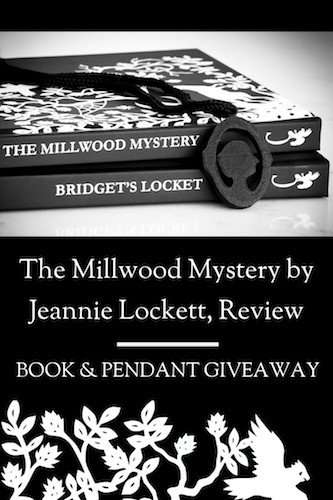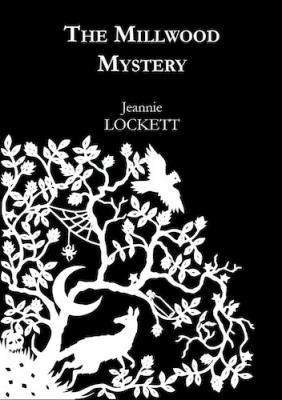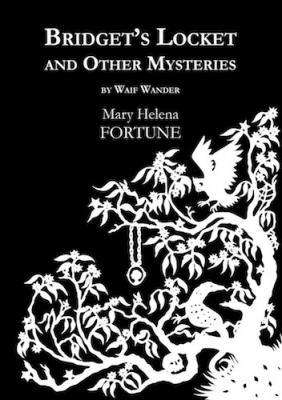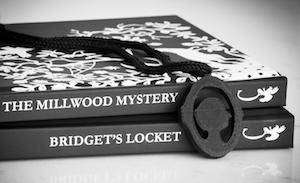The Millwood Mystery by Jeannie Lockett, Book Review
I have just had the pleasure of reading The Millwood Mystery by Jeannie Lockett, one of the launch titles in Corella Press’ 19th Century Australian crime and mystery collection.
 First a little about Corella Press, then more on The Millwood Mystery and its trailblazing author Jeannie Lockett, and of course our review.
First a little about Corella Press, then more on The Millwood Mystery and its trailblazing author Jeannie Lockett, and of course our review.
Then, a little about the other title featured in the collection — Bridget’s Locket and Other Mysteries by Mary Helena Fortune.
And finally, the pendant and book giveaway Corella Press are running to celebrate the publication of these lost treasures.
Corella Press is a not-for-profit small-press teaching initiative staffed largely by University of Queensland (UQ) interns, who source serialised fiction from early Australian newspapers to produce beautiful, thrilling, collectable books for contemporary readers, unearthing forgotten and unrecognised Australian crime and mystery stories.
About the Author, Jeannie Lockett
Jeannie Lockett was born Jane Beattie in New South Wales in 1847, the seventh child of Irish migrant farmers. In Wagga Wagga in 1868, Jeannie married Thomas Lockett, son of a retired British Army officer. They had three children.
Lockett was a teacher before she married, and became a respected headmistress of several Sydney schools, including the Forest Lodge, Camperdown, and Plunkett Street public schools. Lockett poured herself into her writing, of the romance and mystery fiction genres and as a journalist. Many of her fiction stories — including The Millwood Mystery (1886-1887), An Awfully Sudden Death (1887) and The Garston House Tragedy (1888) — were serialised in the Australian Town and Country Journal, Sydney Mail, and Evening News. Lockett’s Judith Grant: A Novel was published posthumously in Britain in 1893 to high acclaim.
As a journalist, Lockett outspokenly advocated for women’s rights—no mean feat in an era where women’s rights, particularly in divorce and labour, were fiercely debated. Her opinion pieces, such as ‘Divorce Considered: From a Woman’s Point of View’, were published in Australian newspapers and notable English journals, including Westminster Review, Nineteenth Century and St James’s Gazette.
Lockett is also credited with inspiring one of Australia’s defining literary voices. Lockett was aunt to Jane Cameron (more widely known as Dame Mary Gilmore) and it is said that Lockett encouraged the young Jane to also become a teacher and writer.
In 1890, Lockett was said to be a tireless worker, making plans to travel to England to pursue literary and publishing opportunities. But she suffered ill health and passed away unexpectedly before her trip, aged just forty-three years old. Jeannie Lockett is buried in Sydney’s Waverley Cemetery.
In her short life, Lockett successfully merged roles unusual for a woman of her time — wife and mother, writer, women’s rights activist, teacher and mentor — and her legacy lives on for contemporary readers today.
Disclosure: If you click a link in this post we may earn a small commission to help offset our running costs.
Sign up to our Booklover Book Reviews emails and receive our gift for new subscribers. LEARN MORE >>
 The Millwood Mystery Synopsis
The Millwood Mystery Synopsis
Originally serialised in the Australian Town and Country Journal (1886-1887), this is the first time The Millwood Mystery has been published in novel form.
The Millwood Mystery is a family tragedy. When Barbara Neill is found dead in her home, the only suspects are also her only relatives. It is the tale of a community’s suspicions and how they have the potential to destroy innocent lives.
Included with the new modern publication is a foreword by author M J Tjia, a handy glossary of words perhaps unfamiliar to modern readers plus Jeannie Lockett’s opinion piece, ‘Divorce Considered: From a Woman’s Point of View’ (Westminister Review, 1890).
BOOK REVIEW
Firstly, I want to allay modern readers concerns as to the readability of this novel’s narrative, given its late 19th century publication.
An excerpt from the ‘Note from the Editors’:
The editors seek to honour Jeannie Lockett and her work by helping twenty-first-century eyes and ears engage with her nineteenth-century words and voice. To this end, inconsistent punctuation has been regulated, spelling discrepancies have been amended to meet contemporary Australian standards, archaic and obscure terms have been explained in a glossary, and language with the potential to offend has been moderated.

So while clearly more accessible than it would have been in its original form, the authorial voice is strong, and the phrasing and dialogue appropriate to the era depicted. Just like any text originally penned more than a century prior, the rhythms and phrasing do take a moment to become accustomed to — but not more than a moment.
I enjoyed the occasional appearance of now deprecated vocabulary, and the languorous, wonder-filled descriptions of the beauty found in the Australian bushland.
Yet, while the soft, hushed air scorned to whisper peace, while the flowers breathed of it, and the moon looked down as its very embodiment, a tragedy was being enacted within one of those rooms into which the moonlight was trying to steal. And from which the lamplight showed faintly—a tragedy which, before many hours, would throw a shadow of horror and mystery over the little town, and which for many a day to come would cast a darker shadow still over several lives.
Mystery and suspense in Millwood
Lockett certainly knew how to cultivate a mood of mystery and suspense in the otherwise sleepy country town, and did so unashamedly from issue to issue, now chapter to chapter. On par with the writers of pay-TV series episodes I’d say, although with a touch more subtlety and class.
The crime mystery itself is not overly elaborate but well developed, and the onion-like reveal orchestrated by Lockett cleverly plotted. And, like all quality historical crime fiction, the ensemble cast features characters to love, hate, pity and mistrust.
Jeannie Lockett’s The Millwood Mystery is an entertaining crime mystery with a satisfying conclusion.
I am grateful that I and other modern readers now have the opportunity to read the work of these pioneers in the Australian crime and mystery genre.
BOOK RATING: 4 / 5 The Story ; 4 / 5 The Writing
Genre: Historical, Crime-Detective, Aussie Author
My receiving a copy from the publisher for review purposes did not impact the expression of my honest opinions above.
Mary Helena Fortune and Bridget’s Locket & Other Mysteries
Bridget’s Locket and Other Mysteries is a triptych, including one novella-length story and two short stories from Mary Helena Fortune, writing as Waif Wander, who is suggested to be the first female crime and mystery writer in the world.
 Bridget’s Locket tells the story of a migrant dressmaker’s search for justice when her travelling companion meets a terrible fate. Joined by two stories about falling in love with a fugitive from the law and murder and bigamy amid goldfields and through the streets of Melbourne, this volume promises a tour of 19th Century Australian crime.
Bridget’s Locket tells the story of a migrant dressmaker’s search for justice when her travelling companion meets a terrible fate. Joined by two stories about falling in love with a fugitive from the law and murder and bigamy amid goldfields and through the streets of Melbourne, this volume promises a tour of 19th Century Australian crime.
~
Mary Helena Fortune was born Mary Helena Wilson in Belfast, Northern Ireland in 1833. As a child, she immigrated with her father to Montreal, Canada. In 1851, at the age of eighteen, Mary married Joseph Fortune and bore a son. When her father immigrated to Australia to try his luck in the Victorian goldfields, Fortune followed with her young son in 1855.
In Australia, Fortune bore a second son and named the father improbably as Joseph Fortune, yet claimed widow status upon her second marriage to Mounted Constable Percy Rollo Brett. Fortune undoubtedly took inspiration from Brett’s detective work when forging her own career as arguably the world’s first female crime-procedural author.
Writing under the famed pseudonym W.W. or Waif Wander, Fortune penned over five-hundred pieces of work, making her one of Australia’s most prolific writers in the late nineteenth century. Her major work, a six- part novel serialised under the title The Detective’s Album, was printed in The Australian Journal, and also collected and published as a book in 1871. Unusual for the age, The Australian Journal paid Fortune an annuity until her death, perhaps in recognition of her decades-long contribution.
Fortune’s later years were plagued by poverty, alcoholism, and blindness. After being institutionalised in 1909, she died in Victoria in 1910 and was buried in a mis-marked grave. Fortune may have been lost forever if not for a book collector’s discovery of Waif Wander’s true identity in the 1950s, and researcher Lucy Sussex, whose academic sleuthing unearthed Mary Helena Fortune’s life story.
~
From 30 August 2019, The Millwood Mystery & Bridget’s Locket and Other Mysteries (hardback, ebook) will be available for purchase from the Corella Press website and Avid Reader Bookshop.
LAUNCH EVENT: Join Meg Vann, Kim Wilkins and Mirandi Riwoe (and the Corella Press team) for the launch of these titles at Avid Reader on 30 August 2019.
Corella Press’ 19th Century Australian Crime & Mystery Collection Giveaway
 Enter via rafflecopter form-link below.
Enter via rafflecopter form-link below.
Open worldwide, entries close 30 August 2019 (AEST).
1st Prize – A beautiful silhouette pendant (6 pendants available)
2nd Prize – Bridget’s Locket and Other Mysteries eBook
3rd Prize – The Millwood Mystery eBook
Fineprint: The photo shows a pendant with a black cord – this is not included in the prize. The photo shows physical books, but the prize is one of either as an ebook. This giveaway (including rafflecoptor entry form) is managed and administered by Corella Press.

